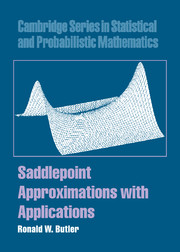Book contents
- Frontmatter
- Contents
- Preface
- 1 Fundamental approximations
- 2 Properties and derivations
- 3 Multivariate densities
- 4 Conditional densities and distribution functions
- 5 Exponential families and tilted distributions
- 6 Further exponential family examples and theory
- 7 Probability computation with p*
- 8 Probabilities with r*-type approximations
- 9 Nuisance parameters
- 10 Sequential saddlepoint applications
- 11 Applications to multivariate testing
- 12 Ratios and roots of estimating equations
- 13 First passage and time to event distributions
- 14 Bootstrapping in the transform domain
- 15 Bayesian applications
- 16 Nonnormal bases
- References
- Index
11 - Applications to multivariate testing
Published online by Cambridge University Press: 25 February 2010
- Frontmatter
- Contents
- Preface
- 1 Fundamental approximations
- 2 Properties and derivations
- 3 Multivariate densities
- 4 Conditional densities and distribution functions
- 5 Exponential families and tilted distributions
- 6 Further exponential family examples and theory
- 7 Probability computation with p*
- 8 Probabilities with r*-type approximations
- 9 Nuisance parameters
- 10 Sequential saddlepoint applications
- 11 Applications to multivariate testing
- 12 Ratios and roots of estimating equations
- 13 First passage and time to event distributions
- 14 Bootstrapping in the transform domain
- 15 Bayesian applications
- 16 Nonnormal bases
- References
- Index
Summary
Saddlepoint methods are applied to many of the commonly used test statistics MANOVA. The intent here is to highlight the usefulness of saddlepoint procedures in providing simple and accurate probability computations in classical multivariate normal theory models. Power curves and p-values are computed for tests in MANOVA and for tests of covariance. Convenient formulae are given which facilitate the practical implementation of the methods.
The null distributions of many multivariate tests are easily computed by using their Mellin transforms which admit saddlepoint approximations leading to very accurate pvalues. The first section concentrates on the four important tests of MANOVA. Very accurate p-value computations are suggested for (i) the Wilks likelihood ratio for MANOVA, (ii) the Bartlett–Nanda–Pillai trace statistic, (iii) Roy's largest eigenvalue test, and (iv) the Lawley-Hotelling trace statistic. Saddlepoint methods for Wilks' likelihood ratio test were introduced in Srivastava and Yau (1989) and Butler et al. (1992a); approximations for (ii) were introduced in Butler et al. (1992b) and were also discussed in section 10.4; p-values for Roy's test do not use saddlepoint methods and are based on the development in Butler and Paige (2007) who extend the results of Gupta and Richards (1985); and p-values for Lawley–Hotelling trace are based on numerical inversion of its Laplace transform in work to be published by Butler and Paige.
The second section considers tests for covariance patterns. Saddlepoint approximations for p-values are suggested for the following tests: the likelihood ratio tests for (ii) block independence, (iii) sphericity, (iv) an intraclass correlation structure; and (v) the Bartlett–Box test for equal covariances. These applications were developed in Butler et al. (1993), and Booth et al. (1995).
- Type
- Chapter
- Information
- Saddlepoint Approximations with Applications , pp. 341 - 373Publisher: Cambridge University PressPrint publication year: 2007

